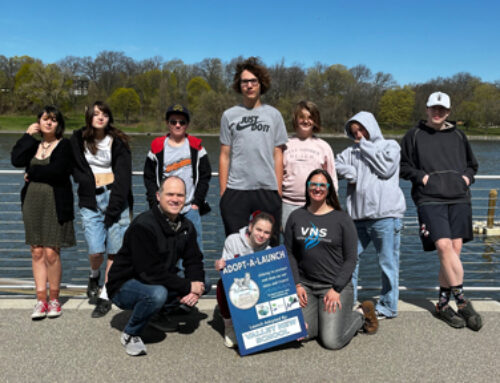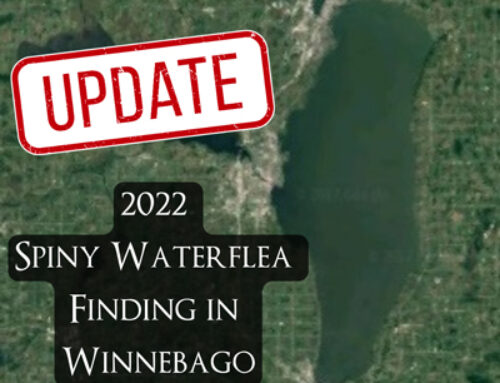 Purple loosestrife is an exotic perennial weed invading wetlands, shorelines, and roadside ditches across the Midwest. After introduction to North America in the early 1800s, purple loosestrife likely traveled to the Great Lakes region in soil used as cargo ship ballast. The purple-flowered plant can be found in dense populations scattered across Shawano and Menominee Counties, particularly around high-traffic lakes and rivers. This noxious plant spreads via roots, stems, and the millions of seeds each plant produces every year. Purple loosestrife takes over wetlands by crowding out native plants which are crucial to waterfowl, birds, insects, and other native fauna. Dense stands of purple loosestrife offer little value to wildlife because the plant is unsuitable for consumption, habitat, and nesting. Being woody and unpalatable, foragers are forced to graze on surrounding vegetation, opening up more space for purple loosestrife to spread. Purple loosestrife has the potential to become so impenetrable it can restrict access to waterbodies and inhibit recreational activities like fishing, hunting, and boating. Loss of recreational value may severely impact local economies that depend on tourism revenue.
Purple loosestrife is an exotic perennial weed invading wetlands, shorelines, and roadside ditches across the Midwest. After introduction to North America in the early 1800s, purple loosestrife likely traveled to the Great Lakes region in soil used as cargo ship ballast. The purple-flowered plant can be found in dense populations scattered across Shawano and Menominee Counties, particularly around high-traffic lakes and rivers. This noxious plant spreads via roots, stems, and the millions of seeds each plant produces every year. Purple loosestrife takes over wetlands by crowding out native plants which are crucial to waterfowl, birds, insects, and other native fauna. Dense stands of purple loosestrife offer little value to wildlife because the plant is unsuitable for consumption, habitat, and nesting. Being woody and unpalatable, foragers are forced to graze on surrounding vegetation, opening up more space for purple loosestrife to spread. Purple loosestrife has the potential to become so impenetrable it can restrict access to waterbodies and inhibit recreational activities like fishing, hunting, and boating. Loss of recreational value may severely impact local economies that depend on tourism revenue.
 After countless efforts to get rid of purple loosestrife, it is clear that we cannot expect to eradicate the weed. However, we can prevent its spread by regulating existing populations through biological control (biocontrol): the use of natural predators to regulate nuisance species. Galerucella beetles control purple loosestrife by consuming leaves and new shoots, preventing purple loosestrife from flowering and producing seeds. Weakening and depleting invasive plants allows native plants to reestablish themselves in invaded wetlands. Galerucella beetles are the best biocontrol agents for purple loosestrife because they are highly selective and pose no threat to native or ornamental plants. In fact, Galerucella beetles are unable to complete their lifecycle on any other plant. Once they have exhausted their supply, the beetles must find another population of loosestrife or perish.
After countless efforts to get rid of purple loosestrife, it is clear that we cannot expect to eradicate the weed. However, we can prevent its spread by regulating existing populations through biological control (biocontrol): the use of natural predators to regulate nuisance species. Galerucella beetles control purple loosestrife by consuming leaves and new shoots, preventing purple loosestrife from flowering and producing seeds. Weakening and depleting invasive plants allows native plants to reestablish themselves in invaded wetlands. Galerucella beetles are the best biocontrol agents for purple loosestrife because they are highly selective and pose no threat to native or ornamental plants. In fact, Galerucella beetles are unable to complete their lifecycle on any other plant. Once they have exhausted their supply, the beetles must find another population of loosestrife or perish.
 Connecting Our Waters is looking for volunteers to help with this fun biocontrol project by raising Galerucella beetles on caged, potted purple loosestrife plants and releasing them into local infested wetlands. This Wisconsin Department of Natural Resources program offers free supplies and beetles. No experience with insects is necessary; we will provide training and assistance throughout the process. Access to an outdoor space within reach of a garden hose is ideal, but we are also looking for volunteers to help with purple loosestrife potting and beetle release events.
Connecting Our Waters is looking for volunteers to help with this fun biocontrol project by raising Galerucella beetles on caged, potted purple loosestrife plants and releasing them into local infested wetlands. This Wisconsin Department of Natural Resources program offers free supplies and beetles. No experience with insects is necessary; we will provide training and assistance throughout the process. Access to an outdoor space within reach of a garden hose is ideal, but we are also looking for volunteers to help with purple loosestrife potting and beetle release events.
Questions? Interested in helping with biocontrol? Please contact:
Anna Bartsch
AIS Coordinator – Shawano & Menominee
anna@fwwa.org
920-851-4336





